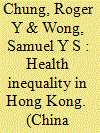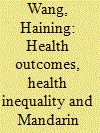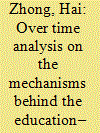| Srl | Item |
| 1 |
ID:
133883


|
|
|
|
|
| Publication |
2014.
|
| Summary/Abstract |
Access to public health care has often been equated with health outcomes. Outcomes-based analysis often misunderstands the process of access to health. This article conceives access to health as a bundled concept and decomposes access into availability, affordability and acceptability. Access to health is determined by public provisioning as well as by socio-economic characteristics of households. It attempts to examine these dimensions across different regions of the Indian state of Uttar Pradesh (UP). It shows that there are variations across regions and socio-economic characteristics of households. A particular group from one region may not have the same degree of access as its counterpart in another region and at the same time there are variations across groups in the same region. The scale of development of regions also plays an important role in promoting or hindering access to health.
|
|
|
|
|
|
|
|
|
|
|
|
|
|
|
|
| 2 |
ID:
078029


|
|
|
|
|
| Publication |
2007.
|
| Summary/Abstract |
A concentration index methodology to analyze the inequality in childhood malnutrition in China is outlined. Height-for-age z-score is used as a measure of childhood malnutrition. Using household survey data from nine Chinese provinces, we found that per capita household income, household head's education, urban residence and access to a bus stop are associated with lower malnutrition. Child's age has a nonlinear relationship with the malnutrition status. Income growth and access to public transportation are associated with less severe inequality, while rural-urban gap, provincial differentials, and unequal distribution of household head's education are associated with higher levels of inequality in childhood malnutrition. Gender is not relevant for either malnutrition status or inequality. Investments in infrastructure and welfare programs are recommended to ameliorate the inequality in childhood malnutrition
|
|
|
|
|
|
|
|
|
|
|
|
|
|
|
|
| 3 |
ID:
173760


|
|
|
|
|
| Summary/Abstract |
The digital divide's implications on health inequality among American Military veterans has been discussed extensively in research; however, it remains unclear what is the association between Internet usage and health specifically among Veterans. We examine this question by addressing the growing digital gaps in the veteran population, looking at the association of Internet use and self-reported health. Using the National Survey of Veterans we find that compared to those who use the Internet daily, those who use the Internet less frequently have significantly higher odds of reporting “fair” or “poor” self-rated health. The significant association remained when demographic, socioeconomic, and military factors were controlled. While our results indicate that veterans that use the Internet more frequently report more favorable self-reported health, given our data we are unable to distinguish a causal relationship. We conclude by discussing potential policy interventions, targeting helping those who are left behind.
|
|
|
|
|
|
|
|
|
|
|
|
|
|
|
|
| 4 |
ID:
141332


|
|
|
|
|
| Summary/Abstract |
Poverty, social disadvantage and ill health are interrelated. Around the world, poorer and more deprived people tend to have poorer health outcomes than the better off and more advantaged people. This health disparity is commonly referred to as “health inequality.” While health inequality is well studied in long-term developed Western populations, research on this subject is relatively new in the more recently developed populations. We will review the evidence of health inequalities across various socio-economic groups in Hong Kong, one of the first Chinese populations in the world to have been experiencing a very rapid economic transition from pre-industrial to post-industrial living conditions over the past few decades. In this article, we will first review the various important dimensions related to health inequality for a more comprehensive understanding of the concept itself. Then, we will describe the history of the population and the general poverty and social deprivation situations in Hong Kong, and move on to summarizing the evidence for the association of social disadvantage with health inequality in Hong Kong. Last, we will identify the gaps in the research literature and propose studies to be conducted in the future for a better understanding of health inequality.
|
|
|
|
|
|
|
|
|
|
|
|
|
|
|
|
| 5 |
ID:
168355


|
|
|
|
|
| Summary/Abstract |
We examine the health returns to proficiency in Mandarin in urban China using longitudinal data from the China Family Panel Studies. We find that greater proficiency in Mandarin improves self-reported health, mental health and capacity to perform activities of daily living. We also examine the relationship between Mandarin proficiency and health inequality and the decomposition results show that differences in Mandarin proficiency account for between 2% and 20% of health inequality in urban China, depending on the health indicator. Our results suggest that promoting ‘standard Mandarin’ can serve as a vehicle to improve health outcomes and reduce health inequality.
|
|
|
|
|
|
|
|
|
|
|
|
|
|
|
|
| 6 |
ID:
143414


|
|
|
|
|
| Summary/Abstract |
In this paper, we examine the over time changes in the relationship between education and health in the past two decades in China. We do not find a clear education–health gradient in the early 1990s. However, the education–health gradient emerges and steadily grows. We test a number of different theories that may explain the observed trend. We show that the mechanisms behind the education–health gradient in developing countries might be different from those in developed countries, and heterogeneous across health measures, both of which may have some important policy implications.
|
|
|
|
|
|
|
|
|
|
|
|
|
|
|
|